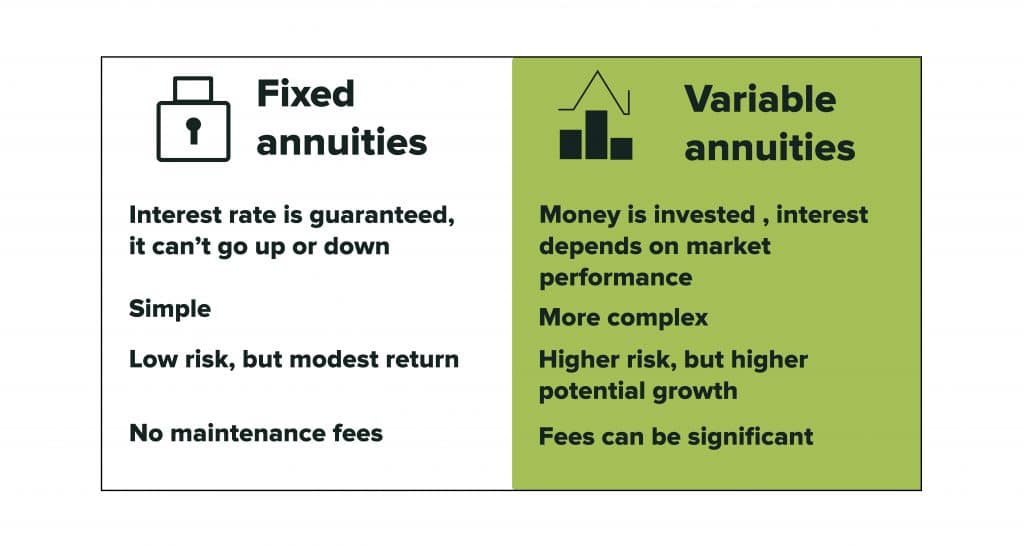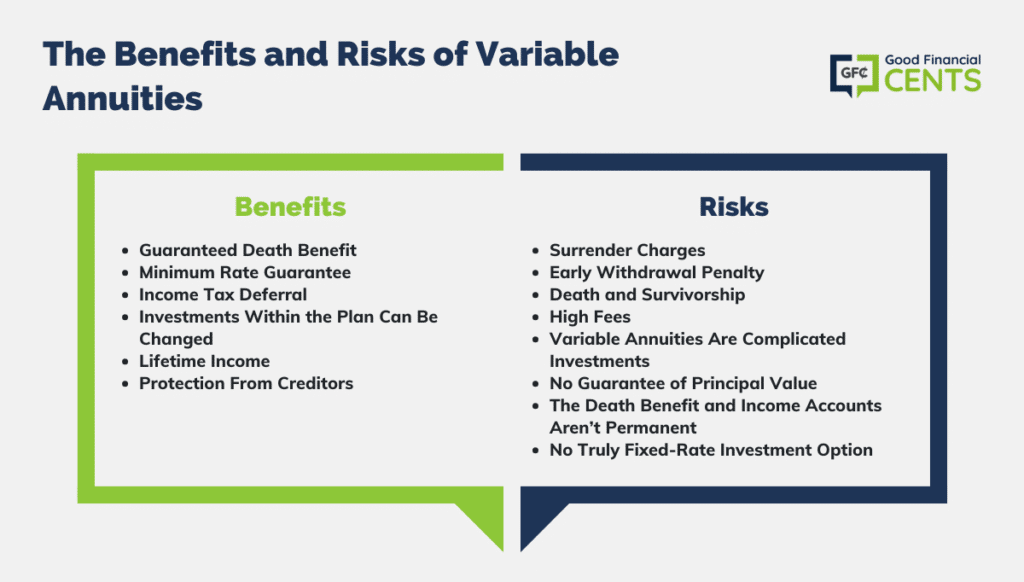All Categories
Featured
Table of Contents
The repayment may be spent for development for a lengthy period of timea solitary costs deferred annuityor invested for a short time, after which payment beginsa solitary premium prompt annuity. Solitary premium annuities are often funded by rollovers or from the sale of an appreciated asset. A flexible costs annuity is an annuity that is planned to be moneyed by a series of settlements.
Owners of dealt with annuities know at the time of their purchase what the worth of the future capital will be that are produced by the annuity. Undoubtedly, the variety of money circulations can not be known beforehand (as this depends upon the contract proprietor's life-span), yet the guaranteed, dealt with rate of interest at least gives the owner some degree of assurance of future revenue from the annuity.
While this difference appears basic and uncomplicated, it can significantly affect the value that a contract owner inevitably obtains from his/her annuity, and it develops considerable uncertainty for the agreement proprietor - Comparing fixed vs variable annuities. It likewise commonly has a material influence on the degree of charges that a contract proprietor pays to the releasing insurance coverage business
Set annuities are often made use of by older capitalists who have actually limited assets but who desire to balance out the threat of outlasting their assets. Set annuities can serve as an effective device for this purpose, though not without particular downsides. In the situation of instant annuities, as soon as an agreement has been acquired, the contract owner gives up any type of and all control over the annuity assets.
Understanding Financial Strategies A Comprehensive Guide to Annuity Fixed Vs Variable Breaking Down the Basics of Investment Plans Pros and Cons of Various Financial Options Why Choosing Between Fixed Annuity And Variable Annuity Matters for Retirement Planning Fixed Vs Variable Annuity Pros And Cons: Explained in Detail Key Differences Between Different Financial Strategies Understanding the Rewards of Long-Term Investments Who Should Consider Strategic Financial Planning? Tips for Choosing What Is Variable Annuity Vs Fixed Annuity FAQs About Planning Your Financial Future Common Mistakes to Avoid When Choosing a Financial Strategy Financial Planning Simplified: Understanding Your Options A Beginner’s Guide to Smart Investment Decisions A Closer Look at Variable Vs Fixed Annuity
An agreement with a typical 10-year abandonment duration would charge a 10% abandonment cost if the contract was surrendered in the first year, a 9% abandonment fee in the 2nd year, and so on until the abandonment fee gets to 0% in the agreement's 11th year. Some deferred annuity agreements contain language that allows for small withdrawals to be made at numerous intervals during the abandonment period scot-free, though these allocations usually come with an expense in the form of reduced guaranteed interest prices.
Equally as with a taken care of annuity, the owner of a variable annuity pays an insurer a swelling amount or series of settlements for the promise of a collection of future repayments in return. Yet as discussed above, while a fixed annuity expands at an assured, consistent rate, a variable annuity grows at a variable price that depends upon the performance of the underlying financial investments, called sub-accounts.
Throughout the build-up stage, assets purchased variable annuity sub-accounts grow on a tax-deferred basis and are exhausted only when the contract proprietor withdraws those earnings from the account. After the accumulation stage comes the revenue phase. With time, variable annuity assets need to theoretically boost in value up until the agreement owner determines she or he wish to start taking out money from the account.
The most considerable issue that variable annuities typically existing is high price. Variable annuities have numerous layers of costs and expenses that can, in aggregate, create a drag of approximately 3-4% of the contract's worth every year. Below are one of the most typical fees related to variable annuities. This cost makes up the insurer for the risk that it thinks under the regards to the contract.
M&E cost costs are computed as a percent of the agreement value Annuity providers hand down recordkeeping and various other management expenses to the contract owner. This can be in the type of a level yearly cost or a percentage of the agreement value. Management costs might be included as part of the M&E danger charge or may be examined individually.
These charges can vary from 0.1% for passive funds to 1.5% or even more for proactively managed funds. Annuity contracts can be personalized in a number of ways to serve the specific needs of the contract proprietor. Some typical variable annuity riders consist of guaranteed minimum build-up benefit (GMAB), assured minimum withdrawal advantage (GMWB), and assured minimal earnings advantage (GMIB).
Decoding How Investment Plans Work Everything You Need to Know About Pros And Cons Of Fixed Annuity And Variable Annuity Breaking Down the Basics of Investment Plans Features of Smart Investment Choices Why Pros And Cons Of Fixed Annuity And Variable Annuity Is Worth Considering Annuity Fixed Vs Variable: How It Works Key Differences Between Fixed Income Annuity Vs Variable Annuity Understanding the Key Features of Long-Term Investments Who Should Consider Strategic Financial Planning? Tips for Choosing the Best Investment Strategy FAQs About Planning Your Financial Future Common Mistakes to Avoid When Planning Your Retirement Financial Planning Simplified: Understanding Your Options A Beginner’s Guide to Fixed Interest Annuity Vs Variable Investment Annuity A Closer Look at How to Build a Retirement Plan
Variable annuity contributions provide no such tax obligation deduction. Variable annuities tend to be highly ineffective vehicles for passing riches to the following generation since they do not take pleasure in a cost-basis modification when the original contract proprietor dies. When the proprietor of a taxable financial investment account dies, the cost bases of the financial investments kept in the account are readjusted to mirror the marketplace rates of those financial investments at the time of the owner's death.
Such is not the situation with variable annuities. Investments held within a variable annuity do not obtain a cost-basis change when the initial owner of the annuity passes away.

One substantial concern associated with variable annuities is the potential for problems of passion that might exist on the part of annuity salesmen. Unlike a financial expert, who has a fiduciary obligation to make investment decisions that profit the client, an insurance policy broker has no such fiduciary obligation. Annuity sales are extremely rewarding for the insurance coverage specialists that offer them since of high in advance sales commissions.
Lots of variable annuity contracts have language which positions a cap on the portion of gain that can be experienced by specific sub-accounts. These caps stop the annuity owner from fully joining a part of gains that could otherwise be appreciated in years in which markets generate significant returns. From an outsider's viewpoint, presumably that financiers are trading a cap on investment returns for the aforementioned assured floor on financial investment returns.
Breaking Down Your Investment Choices Key Insights on Variable Vs Fixed Annuity What Is Annuity Fixed Vs Variable? Benefits of Choosing the Right Financial Plan Why Choosing Between Fixed Annuity And Variable Annuity Can Impact Your Future Fixed Vs Variable Annuities: How It Works Key Differences Between Different Financial Strategies Understanding the Rewards of Fixed Index Annuity Vs Variable Annuity Who Should Consider Annuity Fixed Vs Variable? Tips for Choosing the Best Investment Strategy FAQs About Fixed Annuity Vs Variable Annuity Common Mistakes to Avoid When Planning Your Retirement Financial Planning Simplified: Understanding Your Options A Beginner’s Guide to Smart Investment Decisions A Closer Look at Immediate Fixed Annuity Vs Variable Annuity
As kept in mind over, give up charges can significantly limit an annuity proprietor's capability to move properties out of an annuity in the very early years of the agreement. Further, while a lot of variable annuities allow agreement owners to withdraw a defined amount during the build-up stage, withdrawals yet amount usually cause a company-imposed cost.
Withdrawals made from a set rate of interest financial investment alternative could also experience a "market worth adjustment" or MVA. An MVA adjusts the value of the withdrawal to show any type of changes in rate of interest prices from the time that the cash was spent in the fixed-rate option to the time that it was taken out.

Fairly often, even the salespeople that sell them do not totally comprehend just how they function, therefore salesmen occasionally take advantage of a purchaser's emotions to sell variable annuities rather than the advantages and suitability of the products themselves. Our team believe that investors need to completely comprehend what they have and exactly how much they are paying to own it.
Nevertheless, the exact same can not be said for variable annuity properties held in fixed-rate financial investments. These possessions legally come from the insurer and would as a result be at danger if the company were to stop working. In a similar way, any warranties that the insurer has actually accepted offer, such as an assured minimal income advantage, would be in question in the event of a business failure.
Understanding Financial Strategies A Closer Look at Fixed Income Annuity Vs Variable Growth Annuity Defining the Right Financial Strategy Features of Fixed Index Annuity Vs Variable Annuities Why Choosing the Right Financial Strategy Is Worth Considering How to Compare Different Investment Plans: How It Works Key Differences Between Different Financial Strategies Understanding the Key Features of What Is A Variable Annuity Vs A Fixed Annuity Who Should Consider Strategic Financial Planning? Tips for Choosing Fixed Interest Annuity Vs Variable Investment Annuity FAQs About Indexed Annuity Vs Fixed Annuity Common Mistakes to Avoid When Planning Your Retirement Financial Planning Simplified: Understanding Deferred Annuity Vs Variable Annuity A Beginner’s Guide to Smart Investment Decisions A Closer Look at How to Build a Retirement Plan
Therefore, possible buyers of variable annuities need to recognize and consider the economic problem of the releasing insurance coverage firm prior to entering right into an annuity agreement. While the benefits and disadvantages of different kinds of annuities can be debated, the genuine problem bordering annuities is that of suitability. Simply put, the concern is: that should possess a variable annuity? This inquiry can be difficult to address, offered the myriad variants offered in the variable annuity universe, but there are some fundamental guidelines that can aid investors choose whether or not annuities must contribute in their economic plans.
As the stating goes: "Customer beware!" This article is prepared by Pekin Hardy Strauss, Inc. ("Pekin Hardy," dba Pekin Hardy Strauss Wide Range Monitoring) for informational objectives only and is not meant as a deal or solicitation for organization. The info and data in this write-up does not comprise lawful, tax, audit, financial investment, or other professional recommendations.
Table of Contents
Latest Posts
Breaking Down Deferred Annuity Vs Variable Annuity Key Insights on Your Financial Future Breaking Down the Basics of Investment Plans Advantages and Disadvantages of Different Retirement Plans Why Cho
Breaking Down Variable Annuity Vs Fixed Annuity A Comprehensive Guide to Fixed Vs Variable Annuity Pros And Cons What Is the Best Retirement Option? Benefits of Choosing the Right Financial Plan Why V
Analyzing Variable Annuity Vs Fixed Indexed Annuity Key Insights on Your Financial Future What Is the Best Retirement Option? Features of Annuities Variable Vs Fixed Why Fixed Income Annuity Vs Variab
More
Latest Posts